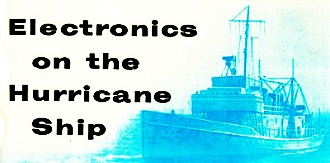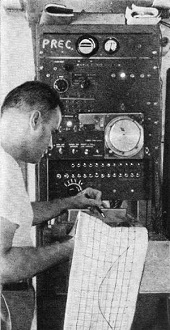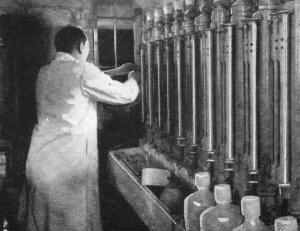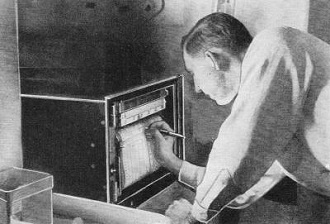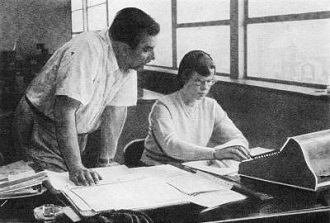Electronics on the Hurricane Ship |
|
If you enjoy reading about instruments with names like theEppley pyrheliometer and the conductivity bridge salinometer, then this article is for you. Long before there were Earth-imaging and environment-monitoring satellites, sonobouys, and autonomous robotic dolphins perpetually roaming the world's oceans, it was up to ships and crews to do the often perilous work. Even with the aforementioned remote sensing technology, it is still necessary for the detailed work to be carried out by humans at the study sites. Raging, swelling, stormy seas imperil the lives and well-being of everything aboard, but don't pity the scientists - they are there because they love what they are doing and thrive on the challenge. It is a seafaring tradition and trait that reaches back to the dawn of time. Landlubbers like myself appreciate the sacrifices of sailors from ancient days of yore as well as today's intrepid explorers. That said, I could do without the types who do "research" based on what the politically correct desired outcome is to prove some scientifically unsound theory ... and it usually involves receiving large sums of money for supporting "the cause." Electronics on the Hurricane Ship The R/V "Crawford," 125·feet long and powered by husky twin diesels, carries fifteen officers and crewmen and seven scientists. Formerly a Coast Guard cutter, she is now the property of Woods Hole Oceanographic Institution. Living quarters are forward in hull while the laboratory is at the aft end of the deckhouse. By Nicholas Rosa Woods Hole Oceanographic Institution Special electronic devices provide measurements of the elements on the world's only hurricane vessel, a pioneer in the important science of oceanography. Everyone has at least a nodding acquaintance with the usual items of shipboard electronic gear. Two-way radio in one form or another has been used since the early part of the century and radio direction finders were an early development. Since World War II loran and radar have come into wide use and before that the sonic depth finder, or echo sounder, had appeared. The world's only hurricane ship, the research vessel "Crawford" of the Woods Hole Oceanographic Institution on Cape Cod, has all of these things, but they are just for getting the ship from one place to another. For her work with the elements, the "Crawford" carries some new developments and others which, if not quite new, are at least exotic. The "Crawford" is not one of the well-known Coast Guard-Weather Bureau weather patrol ships. She is part of WHOI's private fleet, which includes the famous ketch "Atlantis." Like the "Atlantis," she is essentially an ocean-research vessel. A group of scientists at Woods Hole has developed a theory on the origin of hurricanes in which the moods of the tropical ocean play a major role. None of the other Woods Hole ships was quite suited to the work of investigating this theory, and all were tied to other research programs that have years to run. Early in 1956, the "Crawford," a surplus Coast Guard cutter in mothballs, was acquired from the U.S. Department of Health, Education, and Welfare. Several months were spent in refitting and alterations, including the addition of a laboratory deckhouse and changes in living arrangements. Air conditioning was installed for cruising in the tropics, something of a novelty on research ships. (Until the "Crawford" came along, it was traditional for oceanographers to steam like so many clams.) Three electric winches, including a heavy trawl winch, were added to the usual deck gear. To power all this, plus an evaporator to make fresh water from the salty, and all the electronic research tools, extra generating capacity was added in the engine room. The author studying the record of the precision echo sounder. which is far more elaborate than conventional sounders and is only partly pictured here. Double row of toggle switches offers wide choice of "ping" lengths and spacings. The parallel lines on paper are fathom-interval marks. Knob near author's wrist controls width of fathom range. Panel marked "Prec." at top has precision a.c. frequency and voltage meters. Outgoing and returning "ping" can be heard through a pair of headphones. In the summer of 1956, the ship was delivered to the WHOI fleet, and after a couple of weeks spent installing research equipment she set out for the tradewind belt of the North Atlantic, the most common breeding-place of hurricanes. Her assignment was not to look for storms but to study the structure of both the atmosphere and the ocean of the tradewind belt. If she happened to be where a hurricane was starting and could get detailed data on the early stages (which has never been done), this would be considered "good luck." The job of "hurricane hunting" is for the B-50's, once the hurricane is big enough to be noticed. I joined her in San Juan, Puerto Rico, in time to meet Hurricane Betsy, which caught us in San Juan harbor after we had been out for a few days' routine research. The ship was in danger of being pounded against the concrete dock, so we cast off and put out into the wind. The ship handled very well, but we just treaded water until Betsy got by. We had orders not to look for trouble; that was for the hurricane-hunting planes. Betsy was now full-grown; we had missed her birth. I had been assigned to the "Crawford" to help out with radiosonde observations and also to operate one of the newer "black boxes" in the lab. This was the conductivity bridge salinometer, for measuring the salinity of sea water samples. Salinity can be defined as the total amount, in grams, of dissolved solids in a kilogram of sea water. In all the open oceans and larger seas, where land influences do not interfere, all the solids, or "salts," are in a fixed ratio to each other. Sea water is sea water, whether "thin" like the Baltic Sea or "thick" like the central North Atlantic. The composition is everywhere the same, but the concentration varies. The major salts are ionized; that is, they are broken up into constituent atoms or groups of atoms, each bearing an electric charge. Sea water is an electrolyte. For that reason, salt water can conduct electricity. Like any conductor, it has the properties of conductivity and resistance, which are functions of each other. It so happens that the conductivity or resistance of a sample of sea water changes predictably with changes in its salinity, "other things being equal." The most important of the "other things" is temperature. In the salinometer, the sample testing cells sit in an oil bath which is kept at a constant temperature by means of a heating element that is controlled by a thermistor bridge. In this work, the resistance of the sample has to be measured to the hundredth of an ohm, and a good bridge circuit is called for. An ordinary d.c. Wheatstone bridge would present some problems. Electrolysis effects from the d.c. would damage the sample, with the water breaking up into hydrogen and oxygen, certain ions depositing on the testing cell electrodes, etc. The Woods Hole bridge, like earlier Coast Guard models, uses a 1000-cycle a.c. signal which keeps these effects to a tiny minimum, which can be ignored. The sample is connected in the "unknown" arm of the classical bridge circuit. A semi-permanent sample of sea water is carried in an adjacent arm to give both sides of the bridge the same temperature response. The other two arms consist of manual decade resistances. One is the reading arm, which carries a precision potentiometer across part of its circuit for "fine" balancing. The other arm is also variable to compensate for minor variations in the individual testing cells. Rough balancing is done manually, and then electronics takes over. As long as the bridge is unbalanced, a 1000- cycle signal will appear at its output. The signal is fed to a phase detector (like the one in a modern FM receiver) and compared there to a 1000-cycle reference signal. The output of the phase detector is a d.c. voltage, the polarity of which depends on the direction of unbalance of the bridge. The d.c. output is fed to a chopper type servo amplifier which controls a small servomotor. This turns the precision potentiometer in the "reading" arm. When the bridge comes into balance, the d.c. voltage disappears, the servo amplifier output cuts off, and the motor stops. A visual indicator geared to the motor-potentiometer shaft reads the final hundredth of an ohm. The salinometer is checked at intervals against a "standard" sea water carried in sealed glass ampules, and also against standard 500-ohm resistors, which can be substituted for the permanent and "unknown" sea water samples. Salinity affects the density of sea water, and its boiling and freezing points. It has an effect on the vapor pressure of the water surface, and therefore a slight effect on the rate at which sea water evaporates into the atmosphere, although this last effect is usually masked by other forces. Salinity is also part of the environment of all sea life, and partly determines what kind of animals can live where in the sea. This is of vast interest to biologists, fisheries experts, and others, including all consumers of sea food, from pelican to epicure. Scientist puts finishing touches on some of the lab equipment before a cruise. Objects in rack at right are Nansen bottles with deep-sea thermometer frames, used for capturing water samples at different depths. From Nansen bottles samples are transferred to glass or plastic storage bottles which are shown at lower right. By plotting the temperature-salinity curves of water samples, oceanographers can trace water from the Mediterranean all the way over to the western Atlantic, and find Antarctic water flowing under the North Atlantic. Currents like the Gulf Stream can be traced by salinity as well as temperature contrasts with surrounding waters. Currents carry heat from place to place, it being an old story that the Gulf Stream moderates the climate of Europe. They also carry oxygen, nutrients, and vast streams of plant and animal life in the drifting plankton, which is the first link in the food chain running from microscopic algae through shrimp and fish to whales, birds, and men. I have mentioned temperatures as the other identifying mark of a water mass (such as Mediterranean) or a current. It also happens to be a villain in the hurricane story, because water temperatures down to a considerable depth affect the amount of energy (in the form of heat) available for the making of hurricanes. Liquid-in-glass thermometers of various types have served very well in oceanography as everywhere else, but they are fragile and fussy. They cannot be used to give a continuous, automatic record, which is often needed, especially when the temperature profile from the surface to a depth is desired. For many years oceanographers have used a mechanical bathythermograph, or BT, which is a small, torpedo-shaped brass "fish." This is lowered into the depths at the end of a cable, and it traces a record of temperature vs depth on a small smoked-glass slide in its innards. The BT is the sine qua non of ocean research. It is almost hard to imagine an oceanographic ship moving from one dock to another without starting a BT schedule as a regular procedure. Unfortunately, the BT, while rugged-looking and heavy, is vulnerable to thermal as well as to severe physical shock, and is only good to 900 feet. It doesn't take much imagination to know all kinds of things can happen to smoked glass slides as well, including being smudged by the operator's thumb or dropped to the deck and smashed. If a cable breaks or a fitting comes loose in spite of the operator's loving care, more than just a record is lost in the deep. The brass "fish" itself is quite expensive. A group of engineers and technicians at Woods Hole have come up with a thermistor BT. Variations in the thermistor's resistance with varying water temperature will cause corresponding variations in a current sent through it from the ship. This eliminates the delicate glass slides, as the variations can be recorded on a moving-paper chart. This also delivers a record many times the postage-stamp size of the slide. The record is instantly available and a choice of multiplier resistors and chart speeds control the sensitivity. The thermistor must be electrically insulated and protected from the salt water and its pressure, of course. Troubleshooting is fairly easy; the equipment is amenable to all the standard servicing instruments. Comparison resistors switched into the thermistor line give spot-checks on calibration. (Checking the calibration of a mechanical BT is a long and tedious process.) Taking the surface temperature at intervals with a good liquid-in-glass thermometer and knowing that the machine is properly calibrated are all the oceanographer needs for confidence. It is still necessary to know the depth at which the temperature is being taken. The length of "wire out" will not give the answer because of the movement of the ship. There is always a "wire angle" and this is not constant under water. A combination of a Bourdon tube, sensitive to pressure, and a variable precision resistor is the answer to this. The thermistor comes into play again for the continuous recording of surface temperatures as the ship cruises. The usual engine-room thermograph (at the cooling system intake) is not very reliable. A thermistor thermograph can be kept "on the nose" very easily. The "Crawford" carries two thermistors in protective housings below the water line on her bow. Either of these may be switched into a recorder in the lab. For many purposes, the plotting of ocean currents on charts by means of temperature and salinity data is too slow and cumbersome. Sometimes an ocean current will shift, or throw off short-lived "coils" or "eddies." There is another, more direct way of tracing currents in the open ocean, while the ship is cruising in the current. This is the Geomagnetic Electrokimetoqraph, or (understandably) GEK. "Everyone" knows that a conductor moving through a magnetic field will have an electric current induced in it by that field. Sea water is a conductor, and an ocean current is a conductor in motion. The earth itself supplies the magnetic field. The principle of the GEK is as simple as that. The ship trails two electrodes astern, about a hundred meters apart on the same two-conductor cable. They trail far enough back to get away from the magnetic influences of the ship itself. Since the two electrodes are "tapped" along the semi-resistive conductor of sea water, there is a potential difference between them. The GEK turns out to be nothing more or less than a recording voltmeter. The front panel of the conductivity bridge salinometer. Moving chart at right records final .01 ohm of reading: hundreds, tens, and units are read from three manual decades at top right. Other five decade switches are for compensating for differences in the five sample cells set in plastic discs (bottom). The magic eye tube shown at the top right of the panel is also used to indicate bridge balance. A technician records date and time on the automatic record chart of the Eppley pyrheliometer. used for measuring the intensity and duration of sunlight. This record is similar in appearance to that made on other units used in the laboratory. After running four minutes on a base course, the ship turns 90 degrees and runs four minutes more. Then it backtracks over both of these legs. This reverses the polarity of the voltages being recorded and allows a "zero point" or average to be taken. Since the current is moving the ship, the "set" of the ship will show up as a displacement of the trace to one side or the other of the zero line. The two four-minute legs are sides of an electrical right triangle, and the third side can be found by applying the Pythagorean Theorem. This will give the strength of the current after corrections for the vertical intensity of the earth's field, etc. The displacement of the recorded legs with the set of the ship indicates direction. For years sonic sounders have been used in navigation, and a conventional model is used on the "Crawford's" bridge. A very fine version, called simply the precision echo sounder or PES, is part of the laboratory. The PES employs an Alden recorder, in which a strip of chemically treated paper runs between a fixed electrode and a single turn, rotating helix electrode. A current between these electrodes makes a tiny colored mark on the paper. Each time an echo returns from the bottom (or from the scattering layer) such a current flows. Just where the mark appears on the paper depends on where the helix is in contact with the fixed electrode bar which depends, in turn, on the elapsed time since the outgoing "ping" was sent. Paper speed and helix rotation are synchronized so that the fine marks are very close together, making a fairly thick but clean (and clearly readable) line. A precision a.c. supply is incorporated in the unit to insure proper synchronization. This is a husky amplifier using push-pull 807's in the output. The input signal is supplied by an electrically driven, 60-cycle tuning fork in association with a tube. The input circuit is reminiscent of a crystal r.f. oscillator, except that the tuning fork with its magnetic pickup replaces the crystal in its capacitor holder. The PES gives a breathtakingly clear picture of bottom contours, and the operator may select from several ranges at will to bring out fine detail. The paper speed, helix rotation, and timing of the "ping" automatically synchronize for the different ranges. A time marker appears on the paper at frequent intervals. This helps to plot the geographical positions of bottom features to close accuracy, by consulting the navigator's log of "fixes." The paper comes off the instrument in a continuous sheet for constant availability. On it, the machine has electrically marked fathom-interval lines for ease in reading. On other ships, enormous submarine canyons have been discovered by continuous echo sounding. These are often named after the discovering ship. At this writing, the "Crawford" hasn't found hers, but it is fascinating to watch the mountain ranges "come into view" far beneath the ship. With the PES, cruising becomes something like flying. The oceans and the atmosphere have long been regarded as heat engines, and modern oceanographers tend to see air and sea as one heat engine. The fuel, of course, is the sun, and scientists would naturally want to measure the "fuel intake." For this purpose the "Crawford" carries a recording Eppley pyrheliometer, supplied by the U. S. Weather Bureau. This consists of a sensing element, an amplifier, and a recording output meter. The sensing element is a thermopile mounted between two small discs, a white reflecting disc and a black absorbing disc. This assembly is enclosed in a glass bulb about the size and shape of a 100-watt household lamp bulb. Sunlight produces a temperature difference between the white and black discs. The temperature difference acts on the thermopile to produce a voltage which can be measured and recorded by the rest of the system. The sensing bulb sits high in the rigging and the recorder down in the lab. Radiosonde was mentioned near the beginning of this article, and now it rounds out the description of the ship's instruments. Most readers are probably familiar with the radiosonde concept, but perhaps a brief review would be helpful. After a cruise come weeks or months of "working up" data. Colin Macafee, expedition leader of 1956 cruises. goes over scientific logs of ocean "stations," where ship stopped to collect hydrographic and meteorological data. with assistant. A balloon is sent aloft carrying weather instruments and a radio transmitter. The instruments are an aneroid barometer, a thermistor temperature element, and a chemical-on-glass humidity strip. The resistances of the latter two change with temperature and relative humidity. As the balloon rises, the barometer element reacts to the falling air pressure around it. Instead of moving a pointer on a dial face, it moves a contact arm over a printed-circuit switch. With the help of a small relay this switch cuts the instruments in and out of the modulator circuit of the transmitter. On every fifth contact, a fixed resistor is in the circuit to signal a pressure reference. On all other contacts the humidity element is in the circuit. Between contacts, the thermistor is in the circuit. The resistance of each of these elements, in turn, controls the pitch of an audio oscillator, which modulates the 403-mc. signal of the tiny transmitter. The receiver on the ground consists of a superhet, an audio frequency meter and still another moving paper recorder. Several manufacturers make the various units of the system. The operator interprets the frequency record to prepare a chart showing pressure, temperature, and relative humidity vs. height. The results are coded and sent to the Weather Bureau by radio. Radiosondes were used twice a day during the hurricane-season cruises (summer and fall) of the "Crawford" and surface weather observations were radioed to the Bureau every three hours. The ship thus acted as an "operational" weather station for forecasting purposes, as well as an observatory for the hurricane research program. At times the "Crawford" has worked closely with the WHOI flying laboratory, a PBY-6. One of the Woods Hole devices aboard the PBY is a radiometer for measuring sea-surface temperatures from altitudes of a thousand feet or so. The "Crawford's" role was to take surface temperatures by conventional means for calibrating the radiometer, plus surface weather observations to supplement the plane's studies of the structure of the tradewind belt. Recently the radiometer has been able to help unravel some of the intricacies of the Gulf Stream's structure. It is now being used in the hurricane studies, along with other special electronic equipment designed for airborne oceanography. The story of electronics in oceanography does not end here. Many other devices, some just now a-borning, were not carried on the "Crawford" or the PBY for the hurricane work. There are transponder drift buoys, for instance, that answer a radio call from their mother ship or plane so that she can track them. There are also robot hydrographic observers that can be anchored in out-of-the-way spots, even submerged. A sonic call from the mother ship will bring them to the surface, and they then signal their whereabouts by radio. In many of these research aids the circuitry is new. Some ideas await the development or genius-stroke of a usable circuit. In such things as the drift buoys, where power supply is limited and weight and size are critical factors the use of transistors will be important Transistor circuitry will also be useful in sensing elements lowered from a ship. An example is a new salinity-temperature-depth instrument under development for use at the end of a cable. Many of the salinometer functions described earlier will be carried on far under water, by servomotor and other control from the ship. Much of the salinometer circuitry will have to be "packed in the can" along with much of the power supply. Here the transistor with its small power requirement will come into its own. The study of hurricane , big as these storms are in man's way of looking at things, is the study of mere "backfires" in the ocean-air heat engine in the tradewind belt. As every reader knows, a gigantic, coordinated international effort at examining the entire "machinery" of the earth is being made during the International Geophysical Year, 1957-58. The "Crawford" and the other Woods Hole ships are participating in this exciting venture. At the end of January, 1957, the "Crawford" left Woods Hole once more for the tropical Atlantic on a four-month preliminary cruise (the IGY actually runs from July 1, 1957 to December 31, 1958). On this cruise we brought along special sampling equipment for studies of the age of the deep Atlantic waters by the Carbon-14 method, along with the equipment described so far. The hurricane work is not being abandoned in the IGY. All the IGY findings on oceanic and atmospheric energy will probably have a bearing on it. Oceanography is rather new to the public, although it has been recognized as a scientific province for more than a century. Until recent years there was rather little publicity on all that oceanographers have been doing. The field has been growing in scope, size, and importance, especially as land resources dwindle and the world's population increases. The oceans are an untapped source of food, minerals, and energy. Oceanography will soon be recognized as a "new frontier." Its instrumentation will be a new frontier in electronics. We have hardly more than punctured the surface of this virtually unexplored field.
Posted March 11, 2022 |
|

